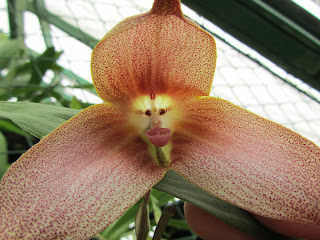Orchid Facts
Caleana major, the Flying Duck Orchid
Monkey Orchid
OUR PLANET EARTH IS SPECIAL - we are lucky to have not only beautiful oceans and awesome animals, but we have a variety of plants and flowers that give us food, shelter and even medicines.One flowering plant family is truly special. It can grow almost anyplace. It can have tiny flowers you can barely see or as big as 11 inches. It can have one beautiful flower on its stem or hundreds on many stems. One variety grows as tall as 75 feet ! Another may only be a few inches in height. It comes in every color of the rainbow, and some are so very dark that they almost appear black. It can look just like an insect, butterfly, or spider. Some have very strange shapes, and several species resemble decomposing small animals and even appear to be infested with maggots. Some smell wonderful, and others smell awful. It has been on the earth from the time of the dinosaurs. Some are fairly common, and some are very, very hard to find. We are talking about a plant with flowers that many people believe are the most beautiful on earth the amazing orchid.
1. Orchids are grown for export all over the world. Orchids in the United States are the second most valuable potted plant crop with over $130 million in annual revenue.
- Orchids grow everywhere on the planet except in Antarctica and extreme deserts.
- Orchids are the largest group of ?owering plants in nature.
- There are more than 25,000 species of orchids. New ones are still being discovered.
- Orchids grow in almost every environment. In the wild you can find them growing on trees, on rocks, in the ground, in rainforests, grasslands, mountains, marshes and bogs.
- Orchids can be found at sea level or high up in the mountains.
- Grow a herb garden in your classroom or at home At home...
- Plant a few flowers that attract butterflies and birds
- Bring flowers to a friend or someone that you care about
- Give an orchid to someone for a special occasion
2. Phalaenopsis (Moth Orchid) - You see these orchids everywhere for sale. They are excellent for your house because they can grow in low light and will still reflower (bloom more than once). Simply make sure not to let them dry out, give them bright light, and some humidity by placing them on trays set over moistened pebbles.
3. Dendrobium (Spray Orchid) - These beautiful orchids need more light and regular watering so they won’t dry out. Plant them in a porous, well-drained growing medium designed for orchids. Place them on trays set over moistened pebbles for humidity. Give them bright light.
4. Other orchids that are good to start with are Cattleyas, Oncidiums, and Vandas. These plants need more light and have different watering needs. Be aware, however! You may find that once you get started growing these amazing flowers, you may be hooked for life!
5. Orchids, because of their long history, variety and beauty, are sometimes cal led “The Royal Family of Plants.” During World War II, England sent many of their orchid plants to America for safekeeping.
6. Moyobamba, Peru, is cal led the “City of Orchids” because there are 3,500 species growing there.
7. The “Bee Orchid” is one example of an orchid that looks like an insect.
8. A tiny bog orchid that grows only in Yosemite National Park is described as smelling like sweaty feet.
9. The hard-to-find “Ghost Orchid” that grows only in deep swampy forests of Florida, the Bahamas and Cuba. It is endangered.
10. The smallest orchid has flowers only half a millimeter or one-hundredth of an inch in diameter! The entire plant is only about a quarter of an inch tall. It grows naturally in the cloud forests in Central America, principally in Costa Rica. You would need a magnifying glass to see the flowers!
11. The largest orchid plant grows canes that can be more than 25 feet long. There are reports of mature plants weighing up to 2,000 pounds and said to produce up to 10,000 flowers. The species is found in Malaysia, the Solomon Islands, Sumatra, the Philippines, Papua and New Guinea. It is called the “Tiger Orchid” or “Sugar Cane Orchid.” Unfortunately, old plants this large probably no longer exist in the wild due to habitat destruction.





















0 comments:
Post a Comment